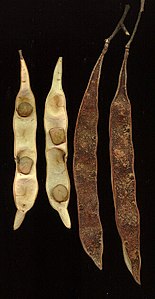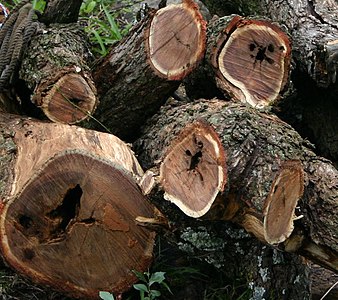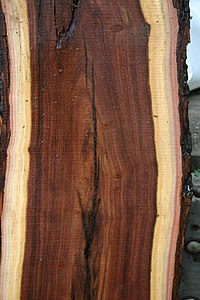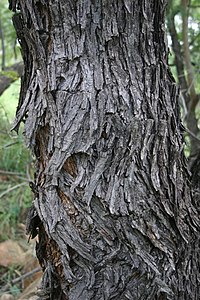| Senegalia afra | |
|---|---|

| |

| |
| habit and inflorescences | |
| Scientific classification | |
| Kingdom: | Plantae |
| Clade: | Tracheophytes |
| Clade: | Angiosperms |
| Clade: | Eudicots |
| Clade: | Rosids |
| Order: | Fabales |
| Family: | Fabaceae |
| Subfamily: | Caesalpinioideae |
| Clade: | Mimosoid clade |
| Genus: | Senegalia |
| Species: | S. afra
|
| Binomial name | |
| Senegalia afra (Thunb.) P.J.H.Hurter & Mabb. (emended)
| |
| Synonyms | |
| |
Senegalia afra, also known as hook-thorn or Acacia afra, is a tree that occurs commonly in southern Africa. Though it is cultivated, it often occurs naturally in Gauteng suburban gardens, together with Acacia karroo and Acacia robusta.
It is up to 10 m (33 ft) tall and may be found in open woodland, grassland, rocky hillsides or watercourses.
Description
[edit]It has extremely hard, dense and attractive timber, and is only spared from intense exploitation because of its strongly twisted trunk which does not lend itself to long planks, and its tendency to develop heart rot.[2] The bark is rough, dark grey and flaking, while the strong, paired hooked thorns are a formidable deterrent on young plants. Twigs which may vary in hairiness from densely puberulous to pubescent or tomentose.[3] Due to its variability the species has been described under many names, some being listed below.
Senegalia afra is deciduous and older plants are resistant to frost, fire and drought. Its appearance may be confused with that of Senegalia ataxacantha or with Senegalia hereroensis, though the former has scattered prickles and the latter has more robust prickles. Together with Dombeya rotundifolia and Erythrina lysistemon, this species is one of the earliest to flower in spring, producing strongly scented flower spikes.[4]
Distribution
[edit]It occurs in the Transvaal, Eswatini, KwaZulu-Natal, Cape Province and the southern regions of Botswana, Zimbabwe and Mozambique. Senegalia afra was also observed, in 1957, by French researchers in the current Central African Republic.[5]
Uses
[edit]Parts of the tree are used by the Bantu in traditional herbal medicine for curing a large range of complaints.[vague][citation needed]
A decoction of the leaves is drunk to treat colds and fever[299]. A leaf decoction, combined with milk, is used as an enema to treat abdominal complaints in children. The leaves are sometimes chewed for the same purpose[299].
A bark infusion is administered as a blood purifier[299].
A number of proteracacinidins (proanthocyanidins) have been isolated from the heartwood, and several cyanogenic glycosides from the leaves[299]
The magical uses in South Africa are numerous. A sprig is placed over a bed to war off evil. It is used in money and love spells and the burned wood stimulates psychic powers
Chemistry
[edit]In common with other Acacias and Senegalias, the bark and leaves are rich in tannins such as proteracacinidin.[6][7][8]
Taxonomy
[edit]The original etymology of its previous species epithet "caffra" is related to kaffir, an ethnic slur used towards black people in Africa. At the July 2024 International Botanical Congress, a vote was held with the result that "caffra" related names will be emended to afra related ones, with the implementation of this happening by the end of July 2024.[9]
Gallery
[edit]-
Flower and leaf buds
-
Pods
-
Logs with heart rot
-
Heartwood/sapwood
-
Trunk/bark
See also
[edit]References
[edit]- ^ Timberlake, J.R. (2020). "Senegalia caffra". IUCN Red List of Threatened Species. 2020: e.T168997539A169318227. doi:10.2305/IUCN.UK.2020-3.RLTS.T168997539A169318227.en.
- ^ ProtaBase
- ^ Flora Zambesiaca
- ^ A Field Guide to the Acacias of Southern Africa - Lynette Davidson, Barbara Jeppe
- ^ Muséum national d’Histoire naturelle. "Acacia caffra (Thunb.) Willd". https://science.mnhn.fr (in French). Archived from the original on 2021-09-20.
- ^ Structure and synthesis of ether-linked proteracacinidin and promelacacinidin proanthocyanidins from Acacia caffra. L Bennie, E Malan, J Coetzee and D Ferreira, Phytochemistry, 2000
- ^ A (4β→ 5)-linked proteracacinidin dimer from the heartwood of Acacia caffra. E Malan, Phytochemistry, 1995
- ^ A novel doubly-linked proteracacinidin analogue from Acacia caffra. E Malan, A Sireeparsad, JFW Burger and D Ferreira, Tetrahedron letters, 1994
- ^ McKie, Robin (2024-07-20). "Botanists vote to remove racist reference from plants' scientific names". The Observer. ISSN 0029-7712. Retrieved 2024-07-21.






Well, that’s interesting to know that Psilotum nudum are known as whisk ferns. Psilotum nudum is the commoner species of the two. While the P. flaccidum is a rare species and is found in the tropical islands. Both the species are usually epiphytic in habit and grow upon tree ferns. These species may also be terrestrial and grow in humus or in the crevices of the rocks.
View the detailed Guide of Psilotum nudum: Detailed Study Of Psilotum Nudum (Whisk Fern), Classification, Anatomy, Reproduction